|
|
|
Sort Order |
|
|
|
Items / Page
|
|
|
|
|
|
|
| Srl | Item |
| 1 |
ID:
164726
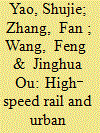

|
|
|
|
|
| Summary/Abstract |
High‐speed rail (HSR) has been an important driver of China's economic expansion over the last decade. Using data of 285 prefecture‐level cities over 2010–2014, this paper proposes an endogenous economic growth model to explain how and why HSR may have propelled China's economic growth by reducing the time‐space between cities. The research results show that HSR has a potent effect on urban economic growth and regional convergence. Ceteris paribus, HSR appears to have accelerated economic growth by more than 0.6 percent and the pace of regional economic convergence by approximately 2 percent per annum over the data period. Our research findings have important policy implications for the sustainability of China's economic development, backed by HSR.
|
|
|
|
|
|
|
|
|
|
|
|
|
|
|
|
| 2 |
ID:
164729


|
|
|
|
|
| Summary/Abstract |
Balancing urban and rural development is an important political goal in China. The failure of rural land privatization has led to a low level of rural economic development and a vast property income gap between citizens and farmers. This paper illustrates the reasons for property income inequality from the perspective of the land tenure system and the dualistic household registration system. After evaluating the segmentation of the rural land market and the rigid nature of rural land assets, a population–land coupling urbanization mechanism is proposed. The paper argues that China's land property system has externalized a high degree of geospatial and social urban and rural intertwinement. Major reform of the rural land property rights system is required to correct the situation (further development of the social security system and stable urbanization) and to increase property income potential for farmers.
|
|
|
|
|
|
|
|
|
|
|
|
|
|
|
|
| 3 |
ID:
164727
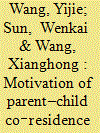

|
|
|
|
|
| Summary/Abstract |
This paper examines the motivations of parent‐child co‐residence behavior in China using data from the China Health and Retirement Longitudinal Study. We test three possible motives: social norms, self‐interest and altruism. We find that social norms play an important role in household co‐residence behavior, showing that the belief that “sons take care of parents” is strong, and children in different birth orders take different responsibilities. Taking the one‐child policy as a natural experiment, we compared co‐residence behavior between only‐child and multi‐child families. This allowed us to test whether children in multi‐child families with wealthier parents more often co‐reside in order to compete for a bequest. We find that parents' wealth is more appealing to children in multi‐child families. The results support the life cycle theory that co‐residence decisions are motivated by self‐interest. We also find some evidence of altruism when parents and children make co‐residence decisions. These findings provide some insights for designing future elder‐support policies in China.
|
|
|
|
|
|
|
|
|
|
|
|
|
|
|
|
| 4 |
ID:
164725
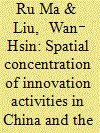

|
|
|
|
|
| Summary/Abstract |
This paper analyzes the development of spatial concentration of various innovation activities in China from 2000 to 2015 by using a generalized Theil index based on a balanced provincial dataset. It tracks concentration development back to the developing heterogeneity within and between regions in general and the mega‐economic zones in particular. Results show that innovation activities tend to be distributed unequally across provinces in China, with more pronounced unequal distribution of innovation outcomes than innovation inputs. Over the research period, the innovation activities considered became more and more equally distributed across provinces. The between‐region inequality of innovation activities has, however, not yet significantly improved, despite the implementation of Chinese regional policies to encourage more equal regional development. Instead, more equal distribution of innovation activities within mega‐economic zones is observed.
|
|
|
|
|
|
|
|
|
|
|
|
|
|
|
|
| 5 |
ID:
164724
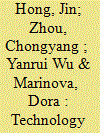

|
|
|
|
|
| Summary/Abstract |
This research adds to the literature studying the effects of outward foreign direct investment (OFDI) on domestic innovation performance and the moderating effect of a technology gap between host and home countries. New definitions of observed technology gap and expected technology gap are proposed. An observed technology gap captures the existing differences in technology level between establishments, regions or countries. An expected technology gap is an indication of the effort of imitating and learning from technology leaders. The corresponding measures and effects of observed and expected technology gaps on OFDI‐induced reverse technology spillover are analyzed. OFDI in developed countries promotes innovation performance. However, OFDI in emerging markets hampers innovation performance. It is also found that regions with a wider observed technology gap and a narrower expected technology gap can benefit more from OFDI.
|
|
|
|
|
|
|
|
|
|
|
|
|
|
|
|
| 6 |
ID:
164728
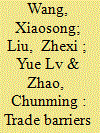

|
|
|
|
|
| Summary/Abstract |
This paper investigates the effects of trade barriers on China's participation in the global value chain (GVC) using a thorough decomposition approach for trade volume, total exports, final exports and intermediate exports. Our econometric results indicate that anti‐dumping (AD) measures initiated by trade partners have restrained the process of China's participation in the GVC. From 2000 to 2014, AD measures reduced the foreign value‐added rate of total, final and intermediate exports by 4.5 to 28.7 percent, 3.4 to 17 percent and 1.2 to 8.5 percent, respectively. In addition, suffering the effects of AD measures, China's GVC position index declined by 8.2 percent to 28.6 percent during this period. Moreover, AD measures have increased industries' upstream index by 3.2 to 13.7 percent over the same period. These results imply that both the petition and approval of AD cases has had a negative influence on the extent and position of China's GVC participation.
|
|
|
|
|
|
|
|
|
|
|
|
|
|
|
|
|
|
|
|
|